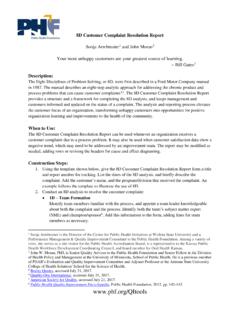Transcription of Facilitating and Coaching Teams: Tips and Techniques
1 Facilitating and Coaching Teams: tips and Techniques Grace L. Duffy, Cathy Montgomery, and John W. Moran (Originally published in Applications and Tools for Creating and Sustaining Healthy Teams, 2011). Facilitating and Coaching teams are learned skills that require education, observation, and hands- on experience. The authors have used facilitation and Coaching Techniques with over a thousand teams to get them back on track and performing at maximum potential. This article includes tips on some effective Techniques for Facilitating and Coaching teams. Facilitation is used in a variety of contexts including training, experiential learning, conflict resolution, and Facilitation is the process of helping groups or individuals learn, find a solution, or reach consensus without imposing or dictating an outcome.
2 Facilitation empowers individuals or groups to learn for themselves or to find their own answers to problems without control or manipulation. Facilitators need good communication skills, including listening, questioning, and reflecting. Coaching is defined as partnering with clients in a thought-provoking and creative process that inspires them to maximize their personal and professional Facilitation and Coaching are closely related. Both facilitators and coaches strive to get clients or teams to improve performance. Coaching is slightly more directive than facilitation.
3 The distinction between facilitation and Coaching often becomes blurred. At times, a group is led through facilitation to a resolution. At other times, directive Coaching is necessary in order to get the group moving. In this chapter the authors assume that the facilitation or Coaching services have been requested by a team experiencing some sort of difficulty reaching their assigned goal. Facilitation/ Coaching interventions must be well planned with the team leader so that additional damage is not done to the team . A facilitator or coach may be assigned to help guide a team through the problem- solving process.
4 The tips and Techniques presented here should be followed at startup to help the team reach its maximum performance level as quickly as possible. Before attempting any team facilitation or Coaching , it is important to make sure that a team Charter is in place as a baseline of the team 's activities. The charter provides start-up direction that a team needs to be successful in tackling the task that it has been assigned. Often teams spend valuable resources trying to figure out what it is they are supposed to do. If the team is struggling with this issue, then the facilitator or coach should get the sponsor together with the team to complete a team charter.
5 1. The CBS Interactive Business Network. Facilitation. intelligence/facilitation. Copyright 2011. Accessed March 30, 2010. 2. International Coach Federation. Copyright 2010. Accessed March 30, 2010. 1. Example: The Florida Department of Health facilitates a collaborative of nine county health departments (CHD) working on quality improvement projects over a three year period to reduce rates of childhood overweight and obesity in their counties. At the beginning of the project, each CHD coordinated a team of peers to develop goals, objectives, strategies and activities; only one team developed a charter, outlining roles and responsibilities of team members.
6 Each year, a survey was conducted among collaborative team members to assess project successes, lessons learned, use of quality improvement tools, and experience participating in a collaborative. A component of the survey asked participants to provide information and feedback on aspects of their team 's performance. Two-thirds (65%) of survey respondents (n = 17) reported that their project teams were composed of multiple program areas within the CHD. No consistency was shown in the frequency of meetings, and even when teams met, only of respondents said that their meetings were productive.
7 Shifts in priorities ( , H1N1; Haitian relief efforts) and staff turnover reduced the number of members available to work on projects in multiple CHD teams. Other team members became disengaged because their role and purpose were not clear. One team member wrote: (QI) projects often assume people know how to work in teams. In fact, it is a skill set that requires just as much training and guidance as any other (QI) tool. If a person functions in a positive team , there is great satisfaction achieved; however, (QI) tools alone and objectives will not prepare people for basics on how to function as a team .
8 Successfully Facilitating and Coaching a team requires building a partnership among the facilitator/coach, sponsor, team leader, and team members. This partnership is most effective when ground rules, clear expectations, specific time frames, and goals and measures of success are established. The overall goal is to build a culture of commitment and accountability to the assigned task within the team . The goal of team facilitation and Coaching is to establish trust, build rapport and open communication, clarify key roles and responsibilities, and establish goals. An effective personal development plan and a mentoring agreement should be created between the facilitator/coach and the individuals within the team .
9 To be an effective facilitator and coach, eight key rules need to be followed: 1. Know the needs of the team . The coach must address current team needs, not some desired future state. 2. 2. Confirm that the team is ready to be coached: a. Will they be receptive to Coaching ? b. Have they requested Coaching or been told to receive it? c. What do they expect to get from Coaching ? 3. Set realistic expectations with the team and team sponsor: a. Establish goals for the Coaching or Facilitating outcomes. b. Clarify whether the purpose is to facilitate a team activity or conduct individual team member Coaching .
10 The difference between the two will show up here. c. Build trust, establishing who is to receive a report of results. Making it clear to the team that the outcome of the Coaching is important will help to build trust. d. Establish when and where Coaching or Facilitating will take place. 4. Observe the team : a. Identify destructive behaviors engaged in by individuals. b. Document specific incidences of inappropriate behavior. c. Document strengths and weaknesses of team members and the team as a unit. d. Understand what team members think is hindering their progress toward the goal.










